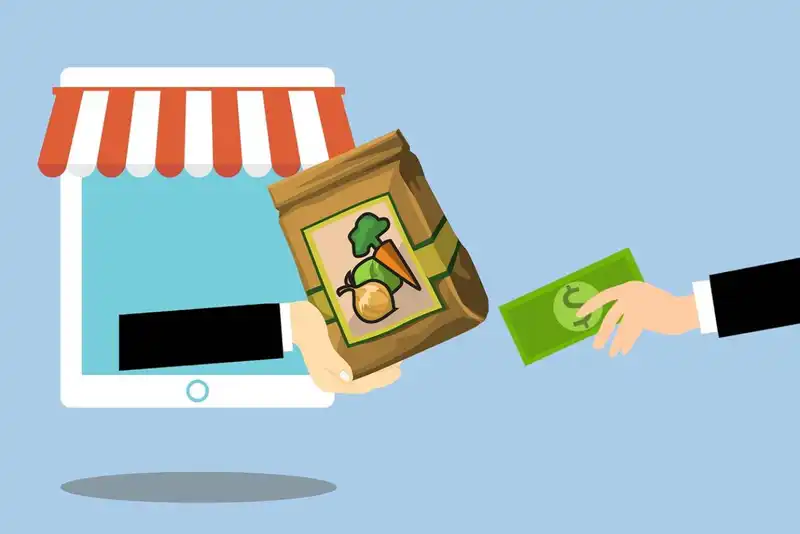What is the food production industry?
The food production industry is a large and complex sector that encompasses a wide range of activities, from farming and fishing to food manufacturing and retail. The industry employs millions of people around the world and is responsible for feeding billions of people every day.
7 Exciting Tech Innovations in The Food Production Industry
Overview of the Food Production Industry in the U.S.

Food is the most basic human need. But, have you ever wondered about the origins of the fancy dishes you have at a fine-dining restaurant, the spicy meals you grab at a food truck, or indeed the modest snack you prepare at home? Food travels along a circuitous path, from the farm to the fork, with various entities involved at each stage of the supply chain.
Food production is, therefore, one of the most important human activities, and involves processes in which raw materials are transformed into edible finished products. The complexity of this process -- to satisfy the needs of an ever-increasing population -- has spawned an entire industry around food production.
In 2020, $1.055 trillion, or 5% of the US GDP, came from agriculture, food, and associated businesses. Out of this, $134.7 billion, or 0.6% of the GDP were contributed by the farm sector alone. More value was added to the GDP by allied activities. The agricultural and food industries employed 19.7 million people in 2020. This translated to 10.3% of total employment in America. Food drew the third-highest spending by US households in 2020 after housing and transportation.
Food manufacturing and food processing are related to the primary production of food, and are important stages in which raw materials are turned into products for either intermediate or end consumption. According to data provided by the Economic Research Service of the US Department of Agriculture (USDA), 1.7 million people were employed in the food and beverage manufacturing sector in the US in 2019. This amounted to around 1% of nonfarm employment in the US. The largest number of food manufacturing workers were a part of poultry and meat plants. Bakeries and beverage units also employed a sizeable number.
The food processing sector in the US contains over 20,000 enterprises, which together generate $750 billion in terms of revenue. This may be seen in the backdrop of global sales of processed food, which adds up to around $2 trillion. The US makes up 37.5% of global processed food sales.
The foodservice sector was bigger than food retailing until 2019. That year, the products supplied by the foodservice and food retail sectors were valued at roughly $1.89 trillion. Foodservice facilities contributed $1.06 trillion of this. However, the foodservice industry suffered its worst loss in 2020 in the wake of the Covid pandemic. The following year, the industry surpassed pre-Covid levels. In 2021, food worth around $2.12 trillion was supplied by the food retail and foodservice sectors, with the share of the latter being $1.17 trillion.
Today, the food production industry has gone tech-forward and increased its efficiency manifold. Technological innovations in this sector have included the use of robots, alternative proteins, restaurant digitization, nutraceuticals, 3D food printing et al. Let's consider some of them in detail.
Robotics - Food Tech Innovation No. 1.
Robots may be incorporated into the entire food value chain to enhance the efficiency, scale, and consistency of food production. They help restaurants address the critical problem of labor shortage. Hospitality robots are provided by food companies in restaurants and hotels to enhance guest comfort and safety. Robots taking care of mundane jobs can free up employees for more important tasks, such as attending to customers.
Examples of food brands using robotics in their kitchens are the casual dining chain Buffalo Wild Wings, and the fast-casual chain The Halal Guys. According to reports in Restaurant Business Online, while a robotic 'chef' has been employed to cook chicken wings at Buffalo Wild Wings, The Halal Guys have planned to use Botrista's DrinkBot to mix premium blended drinks.
Servi, a robot that serves meals autonomously, is another example of advanced restaurant management through robotics. Servi, made by the US-based Bear Robotics, helps waiters carry plates. Its low footprint lets it move through crowded and narrow spaces. It is equipped with sensors and cameras and can halt and change direction if it encounters an obstacle.
The ARK 03 robot from ROBOEATZ, on the other hand, performs tasks like food preparation, cold and hot storage of food, cleaning, sanitization, and so on. It can also order supplies. Drones are proving to be cost-effective alternatives to manual delivery.
Changes are not only apparent on the ground, but also in the air. Drones are an example of this. These remotely controlled devices are environment-friendly and can deliver food much faster, and in a contactless and safe way. Drone delivery could soon do away with the need to employ delivery agents altogether.
Furthermore, food-handling robots and drones in storehouses ensure quick and economical food tagging and monitoring. As a result of tighter food quality control and faster operations thanks to robots, food businesses will be able to significantly boost their revenue.
The food industry is constantly evolving, with new technologies entering it all the time.
It's important to keep up with these technologies if you want to stay ahead.
3D Food Printing - Food Tech Innovation No. 2
3D food printing is the creation of food items using a wide range of additive manufacturing processes. 'Printing' material, contained in food-grade syringes, is released layer by layer through a nozzle to build up a food product. The most popular method of 'printing' food is material extrusion. However, businesses are increasingly adopting inkjet and laser 'printing' of food, apart from bioprinting.
3D food printing essentially involves a viscous substance being built up into a finished product. Ingredients frequently used in extrusion-based 'food printing' have to be soft so that they can be extruded from the syringe or printhead, yet have a sufficiently high viscosity to hold their shape. Powdered ingredients like protein and sugar are sometimes used to improve viscosity. For instance, flour may be added to water in order to make a paste that may be 'printed'.
Generally, ingredients ideal for 'food printing' include jelly, puree, cheese, frosting, and mashed potatoes. The platform for 'printing' food is typically a three-axis stage with an extrusion head that is computer-controlled. This extrusion head uses pressurized air to squeeze out the 'printing' material. The desired food is 'printed' as the extrusion head moves along the stage.
Hot-melt extrusion involves food being heated slightly over its melting point. After being extruded, the molten material quickly hardens. In the case of selective laser sintering, on the other hand, food materials in powdered form are bonded together layer by layer with the laser being used as the source of heat. The binder jetting process uses a liquid binder to bond food materials instead of heat. Inkjet printing is another 'food printing' method, but it is mainly used for decoration and surface filling. It involves edible food ink being dropped onto the surface of foods like cake, cookies, and candy.
An example of 3D printed food is 'Smoothfoods' served by German nursing homes to aged patients, who have difficulty chewing and swallowing. in the US, NASA has been looking to use 3D-printed pizza to offer its astronauts tastier food options. 3D-printed meat is also in the works, where plant-based ingredients aim to replicate the flavor, texture, and aroma of real meat. Such meats will be environment-friendly and cruelty-free.
Transparency and Food Safety - Food Tech Innovation No. 3

Food safety is a major consideration for customers today and they are making it a point to ensure that the quality of the food products they purchase is completely safe. Smart labeling and standalone food grading equipment can help assure them of this.
Developments in blockchain technology enable food brands to offer end-to-end traceability and food monitoring in real-time via the Internet of Things (IoT). Transparency and food safety are ensured with the help of scalable and affordable monitoring tools. This strengthens the trust between consumers and food producers, which benefits the credibility of brands and stands to improve sales.
A technology solution that helps maintain food safety in the foodservice industry is Zip HACCP. This app automates food safety compliance and ensures food quality control in restaurants by making sure businesses follow Hazard Analysis Critical Control Point (HACCP) norms. Zip Temperature is another product that ensures compliance with food safety laws by helping food businesses accurately monitor the temperature of their equipment. Both solutions are available on Hubworks, an app store that caters to the foodservice industry.
Another food safety software solution is Tally. Developed by the Canadian company ThisFish Inc., Tally is in the business of seafood traceability. Using barcode printers, electronic scales, and scanners, the company digitizes real-time data on the food production floor, and uploads compliance paperwork and catch certificates as well.
In addition to software are other safeguards used in food production. Modern drainage systems, for one, provide increased sanitation and safety across food processing units. For instance, the slot drain has a grateless design that is made pre-sloped so that water isn't allowed to stand and stagnate, and the growth of bacteria can be prevented. The slot drain improves on the conventional trench drainage system.
Alternative Proteins - Food Tech Innovation No. 4
One of the most noticeable trends in food technology is the shift away from traditional protein sources, thanks largely to concerns about consumer and Environmental Health. The main sources of alternative protein are cultured meat, plant-based food, lab-grown food, mycoprotein, and even edible insects.
Unlike protein derived from livestock, alternative sources of protein are not only rich in nutrients, but are also less resource-reliant. Costs are reduced too as alternative protein sources need only minimal monitoring.
Viable alternatives to traditional methods of producing protein-rich food are available thanks to developments in 3D printing, molecular biology, and fermentation. These reduce the adverse environmental impact of the industrial production of meat, and address the related moral dilemmas plaguing the food industry.
An example of such animal-free food is the lab-grown Fermotein, manufactured by the Dutch company The Protein Brewery. To produce Fermotein, non-allergenic plants and fungi are brewed with fiber and amino acids. This alternative protein contains 10% fat and has water-binding qualities, giving it a taste similar to that of meat.
Alternative protein can also be produced from algae. Golden chlorella algae are fermented by the Swiss firm Alver to create vegan protein powder. Algae protein is neutral in taste and, therefore, can go with any recipe. Algae protein also emits a lesser carbon dioxide and needs a smaller amount of water than conventional proteins, particularly animal-based ones.
The Malaysian firm Ento produces insect-based protein substitutes from crickets. It raises these insects in a regulated environment to create nutrient-rich food. This alternative protein comprises all nine necessary amino acids and produces a greater amount of protein per gram than beef. Ento's cricket-farming method uses less food, water, and land than conventional livestock farming, which lowers greenhouse gas emissions. Production costs, as a result, can also be lowered.
There's so much to catch up on in the food industry, it's possible to miss out on important developments.
The right industry resources will make sure you're up to speed on everything that matters.
E-commerce - Food Tech Innovation No. 5

The food and beverage industry has been focusing on eCommerce for quite some time. The pandemic encouraged further improvements to food supply chains. Digital platforms are used by food manufacturers to receive online orders and provide online delivery on-demand, and connect with customers via direct-to-consumer (D2C) distribution systems.
Another significant development in the wake of the pandemic has been the rise of ghost kitchens or cloud kitchens. These establishments work solely in the digital space and don't offer dine-in facilities. So ghost kitchens have no storefront, dining room, or front-of-the-house staff. They accept orders from their own websites and third-party food aggregators.
In addition to D2C marketing, firms are concentrating on omnichannel distribution to boost customer satisfaction and revenue. Omnichannel distribution refers to the process by which a product is made available on any channel customers find convenient. After the order is placed on the selected platform, arrangements are made to deliver the product. Food manufacturers can reach their clients more effectively and guarantee a steady flow of supply with the help of eCommerce.
An example of an omnichannel experience is ordering and paying through QR codes placed at restaurant tables. E-commerce can also be undertaken with the help of a smart point of sale (POS) system. Plum POS is one such system. It accepts online orders, prompts deliveries, and enables contactless payments. Plum Handheld and Plum Tablet POS enable order-taking and contactless payments at the tableside. At busy restaurants, Plum self-ordering kiosks let patrons place food orders themselves. Plum POS is available on the Hubworks platform.
The US-based company Orderscape offers online ordering solutions that can be easily integrated with the Restaurant Equipment a business already owns, like its POS devices. The company creates voice bots for restaurants that work with Google Assistant and Amazon Alexa, allowing voice-based ordering of food.
Final Word
The food industry has undergone a radical transformation in recent times, thanks to modern technology. Technology plays a key role in enhancing food shelf-life and safety, and in ensuring affordable prices and reliable quality. What's more, the skillful use of technology has sharpened the competitive edge of businesses. Organizations can now respond quickly to market developments. They are able to test and introduce new items in no time, even as automation ensures better quality control. Product sales can be monitored in real-time too.
Additionally, technology is being employed to improve food safety. For instance, several meat processors record the full origin, distribution, and processing pathways of their products using radio frequency identification (RFID) tags. And then there are companies using low-dose radiation to get rid of microorganisms on vegetables and fruits.
Technology is becoming more and more intrinsic to the process of delivering food from the farm to the table. There's no part of the food supply chain that cannot be improved by it. Thanks to technology, food production for the growing global population can now be made more efficient.
Do you want to know about the latest technologies sweeping the food production industry?
This article has it covered.



